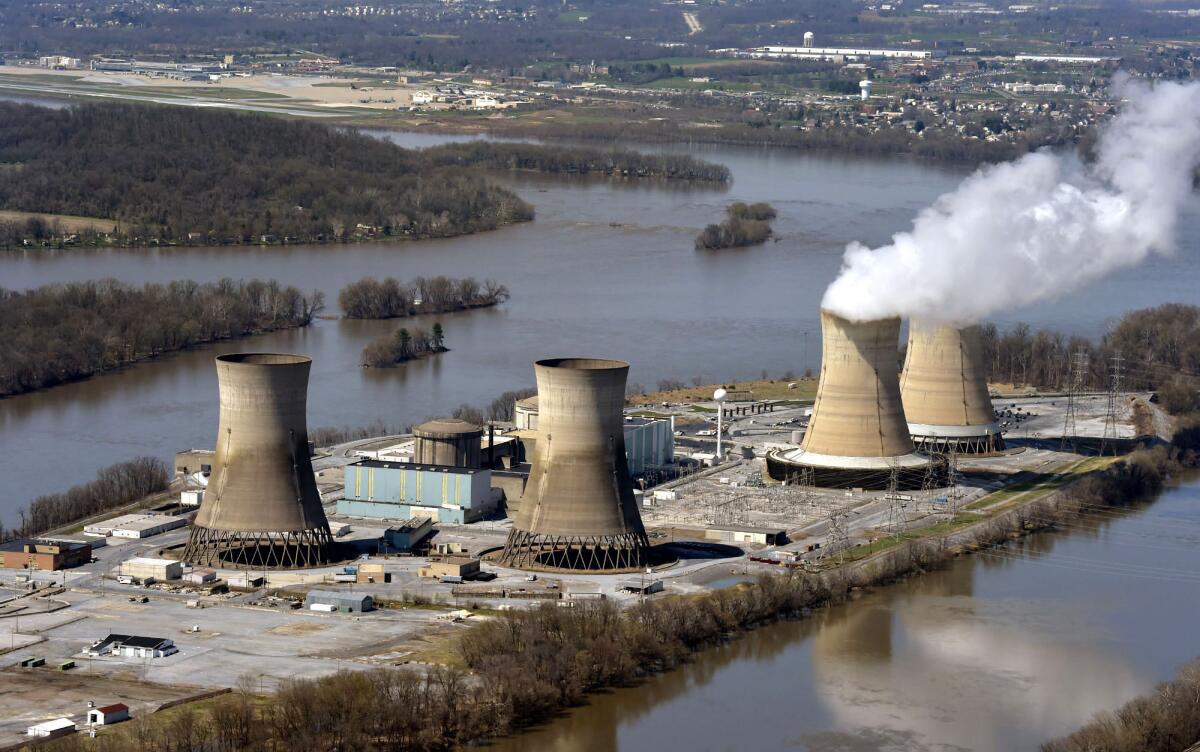Shuttered Three Mile Island may be restarted to supply power to Microsoft’s data centers

- Share via
HARRISBURG, Pa. — The owner of the shuttered Three Mile Island nuclear power plant said Friday that it plans to restart the reactor under a 20-year agreement that calls for tech giant Microsoft to buy the power to supply its data centers with carbon-free energy.
The announcement by Constellation Energy comes five years after its then-parent company, Exelon, shut down the plant, saying it was losing money and that Pennsylvania lawmakers had refused to bail it out.
The plant, on an island in the Susquehanna River just outside Harrisburg, was the site of the nation’s worst commercial nuclear power accident, in 1979. The accident destroyed one reactor, Unit 2, and left the plant with one functioning reactor, Unit 1.
The plan to restart Three Mile Island’s Unit 1 comes amid something of a renaissance for nuclear power, as policymakers are increasingly looking to it to bail out a fraying electric power supply, help avoid the worst effects of climate change and meet rising power demand driven by data centers.
Buying the power is designed to help Microsoft meet its commitment to be “carbon negative” by 2030.
Constellation said it hopes to bring Unit 1 online in 2028 and pursue a license renewal from regulators to extend the plant’s operation to at least 2054. Restarting the reactor will require approval from the U.S. Nuclear Regulatory Commission, as well as permits from state and local agencies, Constellation said.
To prepare to restart Unit 1, “significant investments” must be made to restore the plant, including the turbine, generator, main power transformer and cooling and control systems, Constellation said.
Constellation didn’t say how much money that will cost, and Microsoft and Constellation didn’t release terms of their agreement.
Jacopo Buongiorno, a nuclear science and engineering professor and director of MIT’s Center for Advanced Nuclear Energy Systems, estimated that the cost to restart the reactor will run into the billions of dollars. Microsoft will likely pay above market price for electricity that is both carbon-free and reliable, Buongiorno said.
Restarting the plant is realistic, but not easy, Buongiorno said: “It all depends on what’s the state of the components, the systems.”
The closest example of restarting a nuclear power plant is underway in Michigan, Buongiorno said. There, the federal government has promised a $1.5-billion loan to restart the Palisades nuclear power plant, shut down in 2022.
The business model of the Constellation-Microsoft agreement makes sense for both sides, Buongiorno said. It is cheaper to restart a nuclear power plant than build one from scratch, he said. Already intact are transmission lines, cooling towers, the control buildings and concrete containment structures, he said.
Constellation’s announcement comes after a wave of coal-fired and nuclear power plants have shut down in the last decade as competition from cheap natural gas flooded power markets.
Meanwhile, demand is fast-growing from data centers run by tech giants like Meta, Amazon, Microsoft and Google to provide cloud computing and digital services such as artificial intelligence systems.
In the U.S., growth in electricity demand is concentrated in states — primarily Virginia and Texas — that are seeing the rapid development of large-scale data centers, the U.S. Energy Information Administration said.
The data centers’ share of U.S. electricity use in the United States is around 4%, with some projections expecting that to double by 2030.
The Constellation-Microsoft agreement comes amid a push by the Biden administration, states and utilities to reconsider using nuclear power to try to blunt the effects of climate change and limit plant-warming greenhouse gas emissions from the power sector.
Last year, Georgia Power began producing electricity from the first American nuclear reactor to be built from scratch in decades, after the accident at Three Mile Island froze interest in building new ones.
Before it was shut down in 2019, Three Mile Island’s Unit 1 had a generating capacity of 837 megawatts, which is enough to power more than 800,000 homes, Constellation said.
The destroyed Unit 2 is sealed, and its twin cooling towers remain standing. Its core was shipped years ago to the U.S. Department of Energy’s Idaho National Laboratory. What is left inside the containment building remains highly radioactive and encased in concrete.
Levy writes for the Associated Press.










